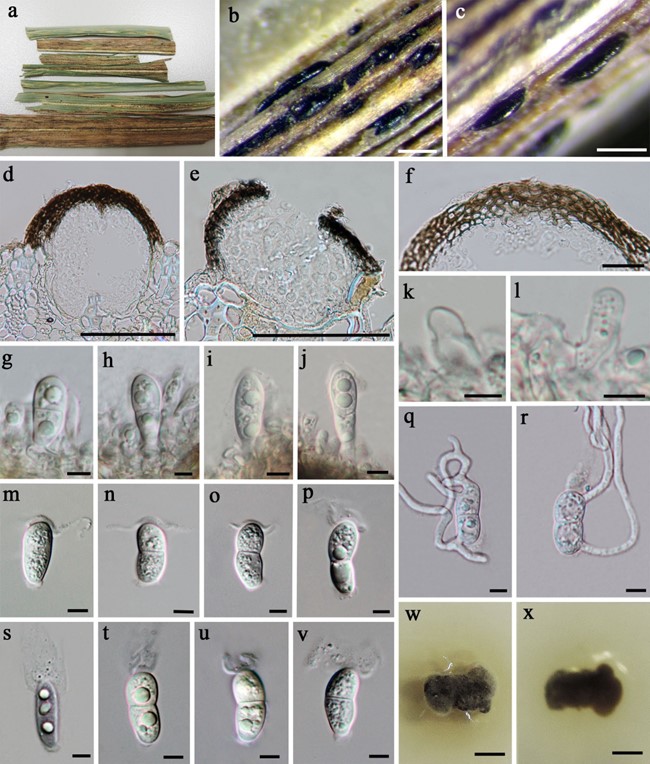Alloneottiosporina thailandica W.J. Li & K.D. Hyde
MycoBank number: MB 557135; Index Fungorum number: IF 557135; Facesoffungi number: FoF 07108; Fig. 15
Etymology: Referring to Thailand, where the holotype was collected.
Parasitic on living leaves of grass, forming conspicuous, small, rounded, black conidiomata. Sexual morph: undetermined, Asexual morph: Conidiomata 100–140 µm diam., 80–140 µm high, pycnidial, separate, gregarious to confluent, globose to subglobose, semi-immersed, unilocular, glabrous, ostiolate, thick-walled. Conidiomatal wall 10–20 µm wide, composed dark brown to brown, thick- walled cells of textura angularis in the above half, becoming hyaline, thin-walled cells in the basal part. Ostiole single, inconspicuous, circular, centrally located. Conidiophores reduced to conidiogenous cells. Conidiogenous cells arising all around the wall of conidiomata, 3–6.5 × 3–7 µm, hyaline, enteroblastic, ampulliform or short cylindrical, determinate, smooth-walled. Conidia 10–17 × 3.5–4.5 µm (x̄ = 15 × 4 µm; n = 30), hyaline, ellipsoid to ovoid, with a broad and rounded apex, and a narrow and truncate base, 1-septate, slightly constricted at the septum, smooth and thick-walled, guttulate, bearing mucoid appendage at both ends; apical appendage tentaculiform, undulate or widely flared, arising from the partial mucoid sheath which initially enclosed the upper part of young conidium; basal appendage small, inconspicuous, slightly flared .
Culture characters: Colonies on PDA, reaching 5 mm diam. after 5 weeks at 20–25 °C, circular to irregular, with sparse, white aerial mycelium, surface olivaceous-black, reverse similar in colour.
Material examined: Thailand, Chiang Rai, on living leaves of grass, 19 March 2015, Jing-Zu Sun, WJL0030 (MFLU 19-2896, holotype), ex-type living culture MFLUCC 15–0576.
Notes: Alloneottiosporina thailandica shares a similar conidia form with the generic type, A. carolinensis, but can be distinguished by the number of septa. Alloneottiosporina thailandica has a single septum, while A. carolinensis has 2–3 septa. Moreover, A. thailandica has smaller conidia than A. carolinensis [20–30(–32) × 6.5–8.5 µm (x̄ = 25 × 7.5 µm)] and A. infundibularis [15 – 34 × (8 – )9 – 10 µm ( x̄ = 24.5 × 9.5 µm)].

Fig. 15 Alloneottiosporina thailandica (MFLU 19-2896, holotype) a Herbarium specimen. b, c Black conidiomata on the host. d, e Ver- tical section of conidiomata. f Vertical section of peridium. k–l, g–j Conidiogenous cells and developing conidia. q–r Germinating spore. m–p, s–v Conidia. w. Culture on PDA. Scale bars: b–c = 200 µm, d–e = 100 µm, f = 20 µm, g–j, m–v, q–r = 5 µm, k–l = 10 µm, w–x = 2 cm
